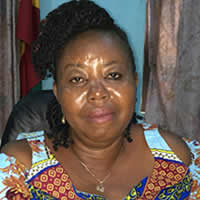District Infrastructure
Transportation Infrastructure
The District has a total road network of 488.50 kilometres. This comprised 312.7 kilometres engineered roads, 52.5 kilometres partially engineered roads, 113.1 kilometres and 10.2 bitumen roads. The only trunk road that passes through the district is Abuakwa-Bibiani road which is about 60.8 kilometres. The road network in the district is generally motorable, however, majority of the roads are not motorable during the raining season and dusty during the dry season. This can be attributed to the number of upper respiratory tract infections which is currently ranked second in the top ten diseases in the district. In addition, the main means of transport in the peri-urban and rural areas are motor cycles popularly called okada. Taxis and Trotro are mostly found on the motorable roads.
Development Implications
The nature of roads in the district is currently hampering the effective transportation of agricultural produces. This is also high waiting time and in some cases non-available means of transport due poor or non-available roads. It is therefore having negative effects on agriculture production and general transportation in the district.
Routine reshaping of the engineered roads and engineering of un-engineered roads should be taken serious in the district development agenda for the next four years considering the ripple effects of good roads in the development of the local economy.
Communication
Telecommunication Networks
Telecommunication in the District is poorly developed. In the case of mobile/cellular phone coverage, only communities alone the main trunk road enjoy a minimum services from MTN. In totality, out of the 310 Communities in the District, about 100 communities representing 32.2 percent are identified to have full telecommunication services whereas the remaining 210 representing 67.7 percent are faced with unreliable telecommunication services. The absence of these facilities tends to make administration and business expensive. It also turns to impede both internal and external interaction.
Television coverage in the District is quite good as most communities in the District have good reception for Ghana Television, TV3, and UTV reception provided one is able to erect a tall pole with a height of about 15 meters and above. However, the reception for TV Africa and other Television Stations in most parts of the District is erratic. In addition, the District has good reception for almost all the radio stations operating in Kumasi and those at Bibiani.
There exist also a number of Community Information Centers (CICs) in the district. The CIC are the major avenues for information dissemination in the district.
Sources of Household Income and Expenditure Items
Household Income
About 60 percent of household incomes fall outside the National and Rural Incomes, showing an indication that the standard of living is low and poverty is prevalent in the District. It is therefore not surprising that the District’s economy is regarded as agrarian as the agricultural sector contributes largely to employment generation and employing 79.2 percent of the economically active persons 15 years and older with 85 percent households engaged in subsistence agriculture (98.6 percent engaged in crop farming) in the District. Even though, agriculture is a commercial venture, the subsistence form of agriculture is the major practice in the district. Table 1.18 presents the major sources of income of households in the district.
Household Expenditure
The main items of household expenditure in the district include food, farming/fishing inputs, clothing, education, transportation and health.Among the expenditures, food (33.8%) recorded the highest expenditure followed by clothing (15.5%), crop farming (14.0%) and business/trading (5.7%) recorded the least. This suggests most household expenditure is spent on food and clothing which form the basic necessities of life. However, the expenditure for education and health which are critical for the betterment of the household in the District are very low. This attributable to availability of social intervention programmes in both education and health such capitation, school feedings, free school uniforms and exercise as well as health
insurance in the health sector. Table 1.19presents the major expenditure items of households in the district.
Date Created : 11/24/2017 3:04:58 AM






 facebook
facebook twitter
twitter Youtube
Youtube TOLL FREE 0800 430 430
TOLL FREE 0800 430 430 +233 593 831 280
+233 593 831 280 GPS: GE-231-4383
GPS: GE-231-4383 info@ghanadistricts.com
info@ghanadistricts.com Box GP1044, Accra, Ghana
Box GP1044, Accra, Ghana